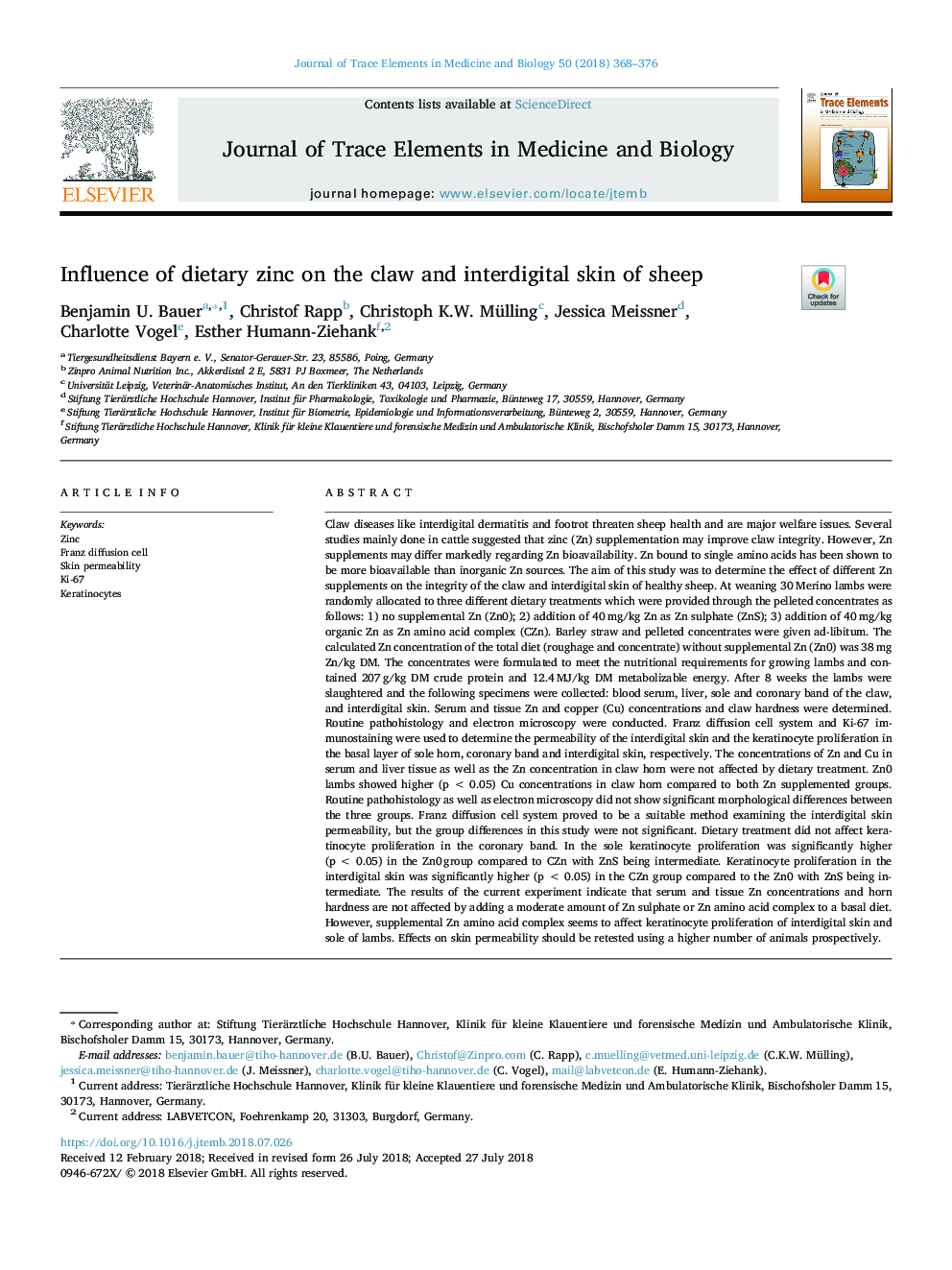| کد مقاله | کد نشریه | سال انتشار | مقاله انگلیسی | نسخه تمام متن |
|---|---|---|---|---|
| 7638830 | 1494806 | 2018 | 9 صفحه PDF | دانلود رایگان |
عنوان انگلیسی مقاله ISI
Influence of dietary zinc on the claw and interdigital skin of sheep
ترجمه فارسی عنوان
تأثیر روی ریه بر روی پوست و ناحیه دهانی پوست گوسفند
دانلود مقاله + سفارش ترجمه
دانلود مقاله ISI انگلیسی
رایگان برای ایرانیان
کلمات کلیدی
موضوعات مرتبط
مهندسی و علوم پایه
شیمی
شیمی آنالیزی یا شیمی تجزیه
چکیده انگلیسی
Claw diseases like interdigital dermatitis and footrot threaten sheep health and are major welfare issues. Several studies mainly done in cattle suggested that zinc (Zn) supplementation may improve claw integrity. However, Zn supplements may differ markedly regarding Zn bioavailability. Zn bound to single amino acids has been shown to be more bioavailable than inorganic Zn sources. The aim of this study was to determine the effect of different Zn supplements on the integrity of the claw and interdigital skin of healthy sheep. At weaning 30 Merino lambs were randomly allocated to three different dietary treatments which were provided through the pelleted concentrates as follows: 1) no supplemental Zn (Zn0); 2) addition of 40âmg/kg Zn as Zn sulphate (ZnS); 3) addition of 40âmg/kg organic Zn as Zn amino acid complex (CZn). Barley straw and pelleted concentrates were given ad-libitum. The calculated Zn concentration of the total diet (roughage and concentrate) without supplemental Zn (Zn0) was 38âmg Zn/kg DM. The concentrates were formulated to meet the nutritional requirements for growing lambs and contained 207âg/kg DM crude protein and 12.4âMJ/kg DM metabolizable energy. After 8 weeks the lambs were slaughtered and the following specimens were collected: blood serum, liver, sole and coronary band of the claw, and interdigital skin. Serum and tissue Zn and copper (Cu) concentrations and claw hardness were determined. Routine pathohistology and electron microscopy were conducted. Franz diffusion cell system and Ki-67 immunostaining were used to determine the permeability of the interdigital skin and the keratinocyte proliferation in the basal layer of sole horn, coronary band and interdigital skin, respectively. The concentrations of Zn and Cu in serum and liver tissue as well as the Zn concentration in claw horn were not affected by dietary treatment. Zn0 lambs showed higher (pâ<â0.05) Cu concentrations in claw horn compared to both Zn supplemented groups. Routine pathohistology as well as electron microscopy did not show significant morphological differences between the three groups. Franz diffusion cell system proved to be a suitable method examining the interdigital skin permeability, but the group differences in this study were not significant. Dietary treatment did not affect keratinocyte proliferation in the coronary band. In the sole keratinocyte proliferation was significantly higher (pâ<â0.05) in the Zn0âgroup compared to CZn with ZnS being intermediate. Keratinocyte proliferation in the interdigital skin was significantly higher (pâ<â0.05) in the CZn group compared to the Zn0 with ZnS being intermediate. The results of the current experiment indicate that serum and tissue Zn concentrations and horn hardness are not affected by adding a moderate amount of Zn sulphate or Zn amino acid complex to a basal diet. However, supplemental Zn amino acid complex seems to affect keratinocyte proliferation of interdigital skin and sole of lambs. Effects on skin permeability should be retested using a higher number of animals prospectively.
ناشر
Database: Elsevier - ScienceDirect (ساینس دایرکت)
Journal: Journal of Trace Elements in Medicine and Biology - Volume 50, December 2018, Pages 368-376
Journal: Journal of Trace Elements in Medicine and Biology - Volume 50, December 2018, Pages 368-376
نویسندگان
Benjamin U. Bauer, Christof Rapp, Christoph K.W. Mülling, Jessica Meissner, Charlotte Vogel, Esther Humann-Ziehank,
